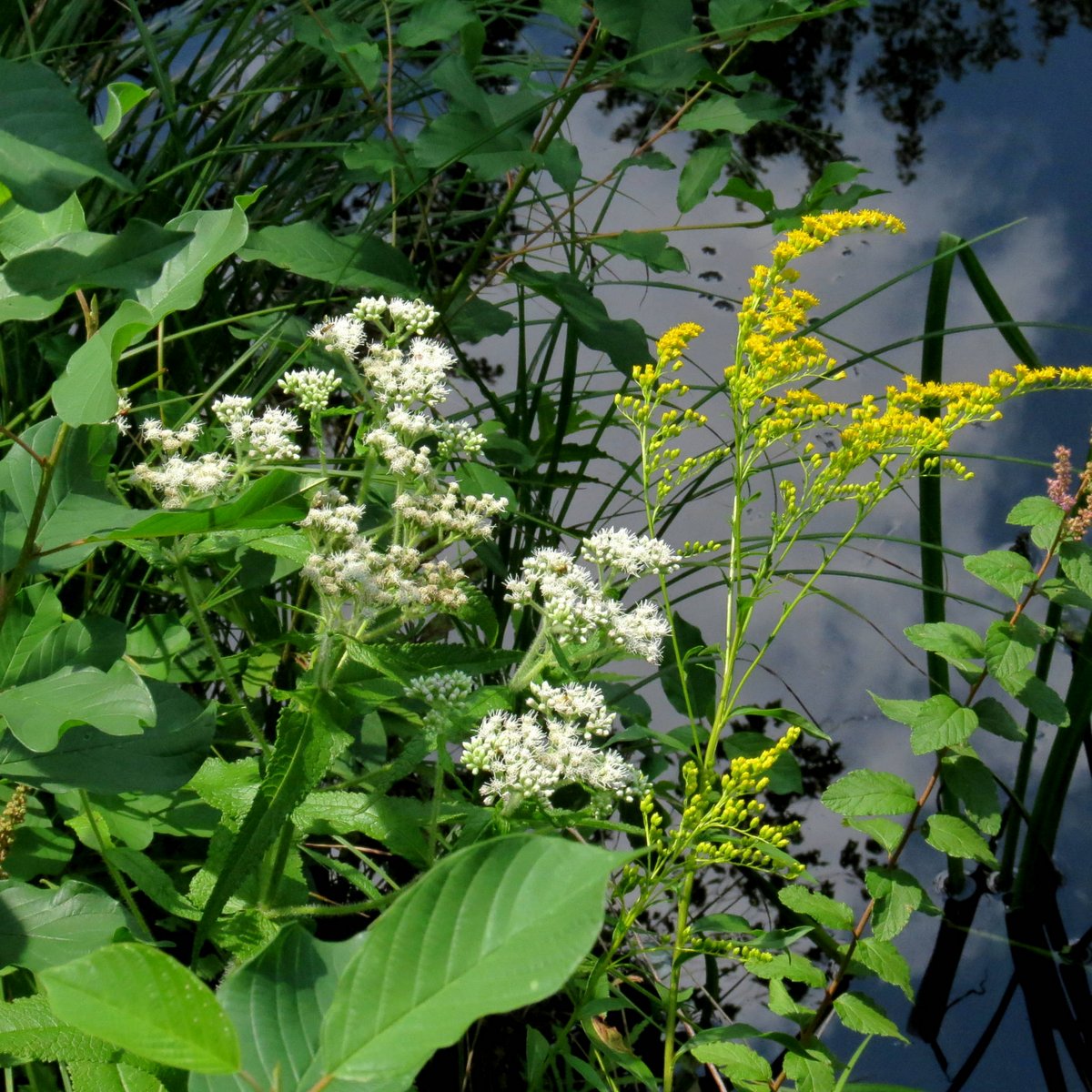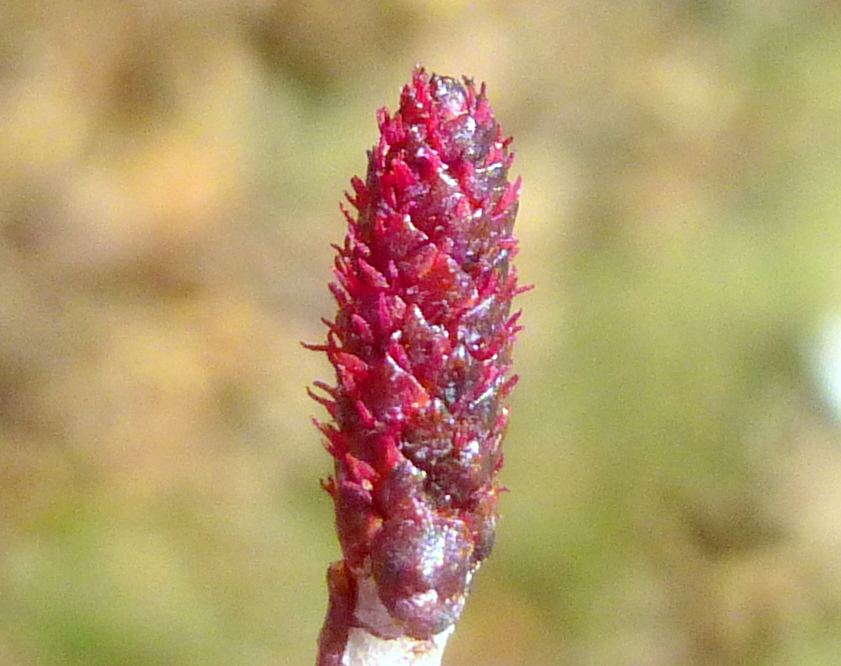
I thought I’d take a break from flower posts this week, not because I’m tired of flowers but because my California friend Dave asked when he would see photos of shagbark hickory buds breaking. They’re easily as beautiful as a flower, but to see them I had to go to the banks of the Ashuelot River. This was no hardship because I started playing on the banks of this river when I was a boy and have loved doing so ever since.

It was beautiful along the river with all the new spring green leaves, but the water level has dropped considerably since the last time it rained. I think it has been close to two weeks since the last substantial rain, and many smaller streams are starting to dry up.

I saw lots of what I think were muskrat tracks in the mud along the shore.

And there were the new shagbark hickory leaves. I couldn’t catch the color I wanted on the bud scales (actually inner scales) in the bright sunshine so I went back the following day when it was cloudy. On this day the beautiful pinks, reds and oranges were easier to capture. It’s not just the light though; some inner bud scales are a single color and others are multi colored like these were. They also lose color quickly as they age so you just have to walk along the river bank and look until you find the one that speaks to you. Fortunately a lot of shagbark hickory buds usually break at the same time so they aren’t hard to find. They’re worth looking for because in my opinion, they’re one of the most beautiful things you’ll find in a spring forest.

This is what they look like when they have spread out to unfurl their leaves. It’s unusual to be able to see this because it usually happens far up in the tree tops, but for some reason in this area the beavers keep cutting the trees. New shoots regrow from the stump and the beavers leave them alone for a while before coming back and cutting them again. Thanks to the beavers there is always a good supply of buds at eye level.

The oaks have also broken their buds, and more new leaves appear each day. Oaks are one of the last buds to break.

Like the maples, oaks can have very colorful new leaves. I’ve seen them in white, pink, red, and just about every shade of green imaginable.

Some new oak leaves even have stripes, as these did. I saw a lot of these leaves in all stages of growth and they appeared to be changing from white to red, which accounted for the stripe. New oak leaves are always velvety and soft.

Some oaks are even showing flower buds already.

Here was a young oak that had barely unfolded its leaves and it was already being eaten by something. It also had three or four oak apple galls on it. They’re caused by a wasp (Amphibolips confluenta) called the oak apple gall wasp. Galls that form on leaves don’t harm the tree so they can be left alone. They’re always interesting to see.

Striped maples (Acer pensylvanicum) are also flowering, with their green bell-shaped flowers all in a string. Sometimes they dangle under the big leaves and other times the wind blows them up and over the leaves as these were. There is only one maple in this region that flowers later, and that is the mountain maple (Acer spicatum).

If you want to see a beautiful, non-flowering plant called the woodland horsetail (Equisetum sylvaticum) you’ll have to leave the trail and go into the forest, but it will be worth the effort to see the delicate, lacy foliage of what is considered the most beautiful of all the horsetails. I was happy to see that they had grown from what was a single plant a few years ago to ten or more now, so they like it here. I originally found them by following a beaver pond outflow stream into the woods.

Woodland horsetails like to grow in bright sunshine in very wet ground. Here they grow right along the water’s edge by this stream. They blend in easily with the foliage of other plants, so you have to walk slowly and look carefully. The sylvaticum part of the scientific name is Latin for “of the forest”, and that’s where you have to search for them.

I found what was left of a wild turkey egg shell by the stream where the woodland horsetail grows. Turkeys nest directly on the ground but I didn’t see any signs of a nest so I wonder if a predator didn’t carry the egg here to eat it. According to the New Hampshire Department of Fish and Game turkeys lay an average of a dozen eggs in early to mid-May, only one per day, and they hatch after about 28 days, so either this hen laid her eggs early or this egg didn’t hatch. If a predator gets to her eggs she’ll lay another clutch in July or August, but normally they lay only once per year. This egg was tan colored, about the size of a hen’s egg I think, with brownish speckles all over it. New Hampshire has an estimated population of 45,000 turkeys. I see them everywhere but they’re almost always running into the woods as I drive by.

If I’m lucky I might see one beech seedling with its seed leaves still intact each year. Here is this year’s seedling. Seed leaves often look nothing like the true leaves. In the case of American beech they look more like flower petals than leaves but feel tough and leathery. On a beech seedling they will photosynthesize until the true leaves appear, and then once they are no longer needed, they will wither and fall off. In my experience they are a rare sight.

Each spring I look for the shoots of the white baneberry (Actaea pachypoda), and each spring they look absolutely identical to the ones I found the spring before. They always look to me like a small hand is holding the plant’s flower buds while an older “parent” gazes down lovingly at them. It always seems like a tender moment has been caught and frozen in time, and it’s always as if I’m seeing the exact same thing I saw the year before. I’ve seen lots of new spring shoots but these are the only ones I know of that never seem to change. They’re like an old friend who comes around once a year to remind me that some things never really change, even though it may seem as if they do.

Mr. robin wondered just what it was I was doing and hopped over to get a better look. Though most robins will hop or fly away if you get too close there are some that are very curious. If you let them come to you they’ll often get quite close, as this one did. I was on my knees taking photos so maybe he wondered why this human’s eyes were so close to the ground while others were not. I didn’t realize what eye movements could do to animals until I watched a show on PBS television that showed border collies herding sheep by using only their eyes. They never bark; it’s all done with eye movements. I’m hoping I remember never to stare into a bear’s eyes again.

I don’t know if this was two trees or one tree that split and grew this way but either way, I’m not sure what would have made it do this. Trees do some strange things.

A big dead white pine fell into a pond and stretched two thirds of the way across it. White pine (Pinus strobus) is New Hampshire’s tallest tree but you often don’t realize how tall they really are until they fall.

A painted turtle looked like it was practicing its yoga exercises on a log, but really it was just releasing heat. I read that when they raise their feet like that it cools them off. Sometimes they look as if they’re trying to fly.

I went to the skunk cabbage swamp and not surprisingly, found it full of skunk cabbages. But that’s not the only reason I come here. Nearby, higher up on drier ground, our beautiful native azaleas (Rhododendron prinophyllum) bloom so I wanted to check their progress. It’ll be another week or so before we see the flowers, depending on the weather.

I saw something bright yellow in a drainage ditch and when I looked a little closer, I saw that the color was coming from swamp beacons (Mitrula elegans). Swamp beacons are interesting “aquatic” fungi and I find them in seeps and ditches where ground water stays on the surface year-round. They will be my first fungal find of the season.

Swamp beacons use a process called soft rot to decompose plant material in low-oxygen areas. Since they only decompose soft tissue, they aren’t found on twigs or bark. I almost always find them growing out of saturated oak leaves, as these were. They are small; about the size of a wooden match, and another name for them is matchstick fungus. These were some of the brightest colored examples that I’ve seen.
Treasures are hidden away in quiet places. They speak in soft tones and often become silenced as we approach. They don’t beg to be found, but embrace us if we do happen to find them. They are the product of completely ordinary circumstances unfolding in wonderfully extraordinary ways. They are found hidden in the nooks and crannies of our existence; all around us if we quit allowing our attention to be captivated by that which is noisy and listen for that which is quiet and still. ~Craig D. Lounsbrough
Thanks for coming by.
























































































































































